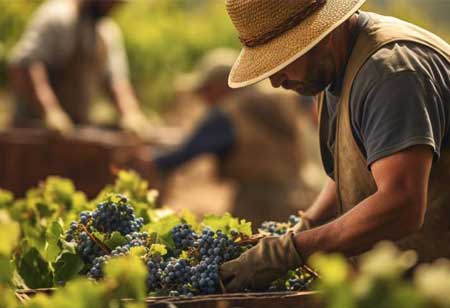Thank you for Subscribing to Agri Business Review Weekly Brief
From Vineyard to Bottle: The Integrated Path to Superior Wine Quality"
Vineyard management is the cornerstone of viticulture, encompassing the practices and techniques employed to cultivate grapevines efficiently and sustainably.

By
Agri Business Review | Monday, February 03, 2025
Stay ahead of the industry with exclusive feature stories on the top companies, expert insights and the latest news delivered straight to your inbox. Subscribe today.
Vineyard management is a key component of viticulture, focusing on the practices and techniques used to cultivate grapevines in a sustainable and efficient manner. The primary goal is to produce high-quality grapes, which serve as the essential foundation for fine wine. This practice combines art, science, and technology, requiring a comprehensive understanding of environmental factors, plant biology, and market demands to ensure optimal grape production. By integrating these elements, vineyard managers can foster healthy vines, maximize yields, and create exceptional wines that meet quality standards and consumer preferences.
The first step in vineyard management is selecting the appropriate site, as the terroir significantly influences grape quality. The term "terroir" encompasses soil composition, topography, and climatic conditions. A site’s suitability depends on factors such as sunlight exposure, temperature variations, and drainage capabilities. For instance, vineyards in regions with mild, warm temperatures and adequate sunlight typically produce fruit with balanced sugar levels and acidity.
Soil preparation follows site selection, as the vineyard soil must support vine health and nutrient uptake. Ideal soils are well-draining and moderately fertile, as overly rich soils can lead to excessive vegetative growth, detracting from fruit quality. In some cases, soil amendments like lime or organic compost are added to adjust pH levels and fertility.
Choosing the right grape variety is another critical decision in vineyard management. Different varieties thrive in different climates and soil types, and the choice often aligns with the desired wine style. Additionally, selecting rootstocks resistant to pests such as phylloxera is essential for vine longevity. Planting density, row orientation, and spacing significantly impact the vines’ growth and fruit quality. Optimal spacing ensures proper sunlight penetration and air circulation, which reduces disease risk and promotes even ripening. Most vineyards align rows to maximize sun exposure, with a north-south orientation commonly preferred in the Northern Hemisphere.
Canopy management refers to the practices aimed at controlling the growth and structure of grapevine foliage. Effective canopy management balances vegetative growth and fruit development, optimizing photosynthesis and ensuring high-quality fruit production. Techniques such as shoot thinning, leaf removal, and hedging are commonly employed to maintain a manageable and productive canopy. Pruning, both in winter and during the growing season, is a fundamental part of canopy management. Winter pruning determines the number of buds left on the vine, which directly affects the upcoming season’s yield and vine balance. Summer pruning, or green pruning, focuses on removing excess shoots and leaves to enhance sunlight exposure and airflow around the grape clusters.
Water is a crucial element in vineyard management, but its application requires precision. Overirrigation can lead to diluted flavors and increased disease susceptibility, while water stress can enhance berry concentration but risks harming vine health. Modern vineyards often utilize drip irrigation systems, which deliver water directly to the vine roots, minimizing waste and allowing for precise control. In some regions, particularly those with established wine traditions, dry farming is practiced, relying solely on natural rainfall. This approach is challenging but can result in intensely flavored grapes and wines that reflect the unique characteristics of the terroir.
Maintaining soil health is vital for sustaining vine vigor and productivity. Regular soil testing allows vineyard managers to monitor nutrient levels and make informed decisions about fertilization. Organic matter, such as compost or cover crops, is often incorporated into the soil to enhance its structure and fertility.
Cover cropping is a widely used practice in sustainable viticulture. By planting legumes or grasses between vineyard rows, growers improve soil structure, prevent erosion, and encourage beneficial insect populations. These plants also compete with vines for water and nutrients, helping to moderate vine vigor in fertile soils. Vineyards are vulnerable to a variety of pests and diseases, which, if unmanaged, can devastate crops and reduce wine quality. Common pests include grapevine moths, mealybugs, and aphids, while diseases such as powdery mildew, downy mildew, and botrytis bunch rot frequently pose threats. Integrated Pest Management (IPM) is the preferred approach, combining cultural, biological, and chemical strategies to minimize pest impact while reducing chemical use. Biological control involves introducing natural predators like ladybugs or parasitic wasps to manage pest populations. Cultural practices, such as canopy management and sanitation, further reduce disease risk.
In organic and biodynamic vineyards, chemical inputs are replaced with natural alternatives, such as sulfur sprays for mildew and compost teas to enhance vine immunity. While these methods require more labor and vigilance, they align with growing consumer preferences for sustainable wines.
Climate change poses significant challenges to vineyard management, affecting grape ripening patterns, disease prevalence, and water availability. Vineyard managers now employ advanced tools, such as weather stations and remote sensing technologies, to monitor climatic conditions and make timely interventions.
To combat the impacts of heatwaves and droughts, techniques like mulching, partial shading, or using heat-tolerant rootstocks are being adopted. In cooler regions, practices such as delayed pruning or using wind machines to prevent frost damage are common.
Vineyard management is a complex interplay of science, tradition, and innovation. From selecting the right site and grape variety to adopting sustainable practices and leveraging advanced technologies, every decision impacts the quality of the final product. As the industry faces challenges such as climate change, resource scarcity, and shifting consumer preferences, the role of adaptive and sustainable vineyard management becomes ever more crucial. By embracing both time-tested practices and cutting-edge innovations, vineyard managers can ensure the enduring legacy of winemaking while protecting the environment for future generations.





